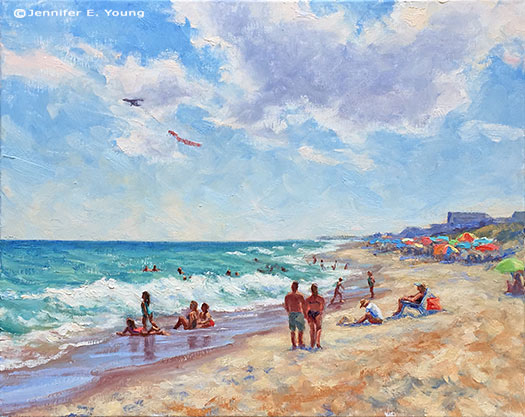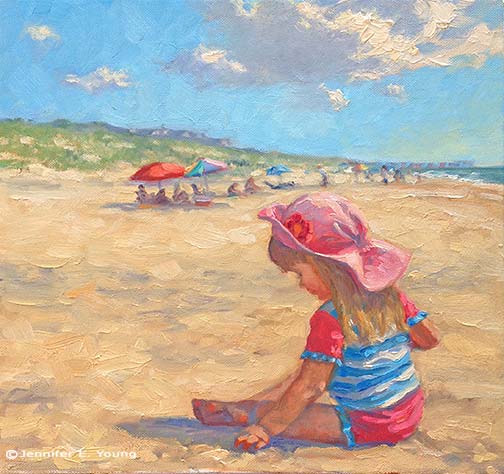Summer by the Shore
/As much as I love the dramatic light of a sunrise or sunset at the beach, full-on sunshine makes me conjure up lazy days and summer vacations. So as I sent my wee-one off the kindergarten today I guess I can admit that I have been feeling a little nostalgic (already!) for those long duty-free days filled with sandcastle building, sun and sand between my toes:
 "Summer by the Shore"
Water Miscible Oils on Linen, 16x20"
To purchase, contact me!
"Summer by the Shore"
Water Miscible Oils on Linen, 16x20"
To purchase, contact me!
I had such a fun time with this one. It was almost a way of teleporting myself back to the beach. I especially enjoyed painting the figures. Here is a detail of some of them:

In fact, I had so much fun that I may even do another painting with just these two girls frolicking in the waves.
As I mentioned in my prior post, I am loving painting in the studio with water miscible oils. I will still work with traditional oils outdoors, mainly because I have quite a large supply of them in my stock. But gradually, in spite of some early struggles, I feel I am getting the hang of painting with the WS variety. I am loving that they are solvent and odor free, and have managed to work with them in a way that creates a lovely rich texture. This is helped greatly by my new Rosemary & Co. brushes, I might add. If you paint, do yourself a favor and check these out!
One of my struggles early on was that the water soluble oils weren't playing too well with my natural bristle brushes. Even after I realized that I shouldn't thin with water and wipe the water out of my brushes thoroughly between washing, my bristle brushes would get fairly flabby after a while. I really dislike synthetic brushes because they lack the spring and paint load abilities of a natural hair. Enter Ivory and Eclipse brushes by Rosemary & Co. These are synthetic brushes, but they behave much more like natural hair bristle brushes. Amazing! They really hold the paint and have just the right amount of spring in them. And the prices are quite reasonable as well. If I were to pick just one type ( though why would I want to do that?!) I'd go for the Ivory because they are more like the bristle brushes I normally paint with for my direct painting method. But the Eclipse, which are touted as a "synthetic mongoose" are really nice as well for finer details and soft edges. I really look forward to trying out some of the other styles as time and money allows. Meanwhile, I think I'll head back to the beach soon (by way of the easel!)


 Â
 













 . Leonard is an aikido master so a lot of his analogies in the book are drawn from the martial arts and Zen philosophy. According to the author, one of the keys of mastery is entitled "Surrender":
. Leonard is an aikido master so a lot of his analogies in the book are drawn from the martial arts and Zen philosophy. According to the author, one of the keys of mastery is entitled "Surrender":


 One of my favorites from this period
"Faith", Oil on Canvas (sold)
One of my favorites from this period
"Faith", Oil on Canvas (sold)













